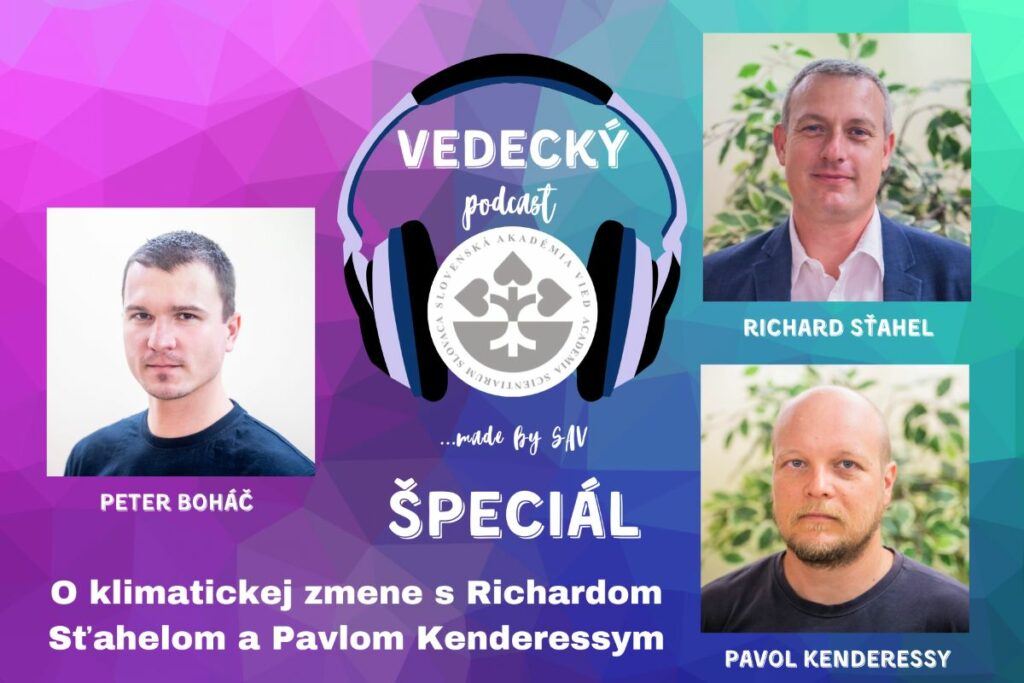
After the summer break, the 3rd season of the SAS Science Podcast starts. The latest episode is a special. which deals with a highly topical topic – climate change. The guests of the moderator Peter Boháč were the director of the Institute of Philosophy of the Slovak Academy of Sciences, doc. Mgr. Richard Stahel, PhD., and Mgr. Pavol Kenderessy, PhD., from the Institute of Landscape Ecology of the Slovak Academy of Sciences. They talked about the causes of climate change, the possible extinction of some organisms, the impact of carbon dioxide, emissions and the importance of politicians in this ongoing crisis. There was also talk of the so-called “greenwashing”, but also of China as the largest producer of CO₂ per year. Last but not least, the podcast was also devoted to a popular-educational publication – Climate Change Part I, recently published as part of the Open Academy project.
“The aim of the first part of the publication is to provide a general cross-sectional picture of what climate change is, what its consequences are at the global level or what are the basic principles and processes that condition climate change,” explained P. Kenderessy. He added that it was published just at the time when Czech scientists published the study Slovakia and Climate Change, according to which the Slovak public does not understand very well how climate change is taking place and what its main driving forces are. “Our publication provides answers to these fundamental questions.”
Richard Stahel confirmed that climate change already affects everyone. “Everyone is already feeling its impact on their own skin,” he pointed out, naming the specific problems and manifestations of climate change that we have observed this summer as well.
P. Kenderessy will also explain the concept of climate change in the podcast. “We are talking about this global phenomenon mainly in connection with the rising concentration of carbon dioxide in the atmosphere, which disrupts natural global cycles,” explains the landscape ecologist, again giving examples and pointing out the unflattering influence of man in these phenomena. The discussants will stop at the increase in global surface temperature from 1950 to the present by an average of one degree Celsius. For a layman, it may be an insignificant increase, but it is an average increase, so locally it can mean a lot somewhere, the scientists warn, again documenting it on specific cases. Once again, they unanimously emphasized the importance of finding solutions to this crisis: “All civilizations that could not adapt to climate change have disappeared.”
They then pay increased attention to the “main culprit” carbon dioxide, as the main cause of global climate change. “It is a natural element that has always been in the atmosphere and whose concentration has fluctuated,” explains P. Kenderessy, describing where the turning point occurred, or what caused the CO₂ concentration to rise sharply and how the origin of the increased CO₂ can be accurately determined. “Based on historical research, we can very accurately characterize the development of climate and temperature in the very distant past and compare it with current data,” says the landscape ecologist. Therefore, there is no doubt that the changes have occurred through the action of man.
Scientists have not forgotten to consider some of the claims that climate change does not exist at all and that it can be caused by humans. However, according to R. Stahel, there are also some changes in the statements and he also adds specific examples. However, it is striking that the climate crisis is also denied by some of the so-called elites of society, opinion-forming people. According to the philosopher R. Stahel, it is related to the setting of the organization of society and the functioning of politics. “We do not place any qualification requirements on people who manage society and make fundamental decisions,” says R. Stahel, “society will not be able to live according to the rules that were created in a different climate regime.”
The podcast also gives the answer to what carbon neutrality is and whether we can “preserve” fossil carbon, or what role the forest plays in CO₂ absorption. Scientists will not avoid the topic of the role and use of nuclear energy. “Nuclear energy is very important for the preservation of civilization,” emphasized R. Stahel, and together with P. Kenderessy they talk about its advantages, but also pitfalls.
They also talked about the impact of the current war in Ukraine on climate change. “War – like any military conflict – means a huge increase in CO₂ emissions. At the same time, it means more armament or exercises in other countries, and instead of the expected and necessary decrease, there is an increase in emissions,” the philosopher points out.
In terms of forecasts of whether we can fight climate change, build an environmental society or reduce the temperature by 1.5 °C, scientists are quite sceptical and emphasize that we would have to change the entire way of thinking and functioning of society, it would certainly also mean huge costs for changing infrastructure. Any positive prognosis requires an “elementary change in human thinking”, SAS scientists agree. However, Richard Stahel and Pavol Kenderessy are rather pessimists and sceptics.
You can find the SAS Science Podcast in podcast apps PodBean, Apple Podcasts, Google Podcasts, on Spotify and www.podcasty.sme.sk. You can also listen to the full interview with our guests by clicking on this URL link – https://youtu.be/6IxhKXd4jVw?si=1hr5JYNr-ZUCuecd
Edited by: Andrea Nozdrovická
Photo and graphics: Martin Bystriansky



